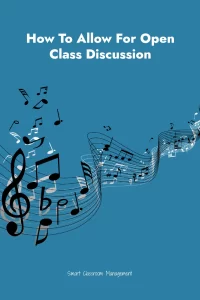
One of the most common questions I receive is: “How can I allow for free-flowing discussion given the SCM rule about hand raising?”
This is a great question because at first glance our classroom management plans don’t allow for open, back-and-forth interaction among students and teacher.
The rule states: Raise your hand before speaking or leaving your seat.
Thus, presumably, if a student wants to lend voice to a discussion, they must first raise their hand and wait to be called on.
—Which, if you’re debating about the causes of the American civil war or your students are especially passionate about a particular topic like modern space flight or AI, can be stifling. This isn’t to say that open discussion is always a good thing.
However, in the hands of a competent teacher and eager students, it can be beneficial.
So what’s the answer? Does the hand raising rule leave any room for give-and-take debate or will allowing it just confuse your students?
The answer is that it does leave room. You can indeed conduct free-flowing conversation in your classroom while still maintaining the integrity of the rule.
Here’s how:
1. Define it.
Give it a name, like “open discussion time.” Define precisely what it is and why it’s good for the class. Set exacting parameters, including the signal to open the discussion and the signal to close it.
Also, be sure to point to the hand-raising rule and how it’s to be set aside during this singular specific and narrow window.
2. Teach it.
For open discussion to work, your students need to have the skills to navigate its jazz-like flow. They need to know how to contribute, how to further the conversation, how to politely address one another, how not to interrupt, etc.
This needs to be taught explicitly and directly. It needs to be modeled by you and a small group of students while the rest of the class gathers around to observe and learn its proper protocol and etiquette.
3. Practice it.
To achieve the benefits of great discussion, you first need to practice in small doses. Try five minutes and choose simple, relatable topics like, for example, why mint chip ice cream is so popular.
Slowly increase the length of time while mixing in academic topics.
By gently pushing the envelop on length and complexity, you’ll get to a level that allows you to use open discussion in a way that draws students deeper into the subject.
But it takes commitment to the three steps above to avoid confusion over the hand-raising rule and its importance, as well as the disaster that open discussion can become.
PS – Be sure to subscribe to our YouTube channel. The latest video is How To Build Effortless Rapport.
Also, if you haven’t done so already, please join us. It’s free! Click here and begin receiving classroom management articles like this one in your email box every week.

You have provided us with a clear, practical framework for balancing structured classroom management with the benefits of open discussion. The step-by-step approach—defining, teaching, and practicing—offers teachers both flexibility and control, ensuring that students can engage meaningfully without undermining established rules. It effectively highlights the importance of structure, modeling, and gradual practice in making open discussions productive rather than chaotic.
I appreciate this article on this topic. It would be very helpful if you had a short video that the students could watch on how to conduct open discussion. I would love to do this, but I’m already swamped with other things to teach them.
Michael,
My classes use the hand-raising rule even during discussions and it generally works well. I tend to call on several students at a time, give them time to share or ask questions, then call on more etc. Sometimes we use other strategies as well which can be a bit more flexible, as you demonstrate here.
Love your blog. Keep up the good work.